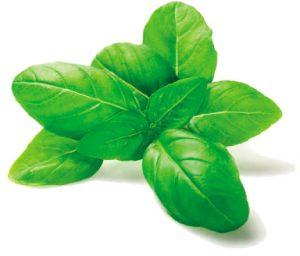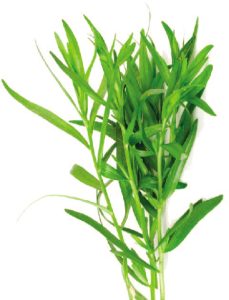 Though summer is here, it’s not too late to add a few more herbs to your garden. Herbs such as basil, peppermint, and tarragon can be found in abundance this time of year and make for amazing additions to your garden as well as dishes you may already eat. Here’s how to grow and harvest these summer herbs to create new and refreshing meals or add them to your favorite treats.
Though summer is here, it’s not too late to add a few more herbs to your garden. Herbs such as basil, peppermint, and tarragon can be found in abundance this time of year and make for amazing additions to your garden as well as dishes you may already eat. Here’s how to grow and harvest these summer herbs to create new and refreshing meals or add them to your favorite treats.
Peppermint
 A great thing about peppermint is its hardiness. Resistant to bugs and disease, this herb can be planted in the spring or in the heat of summer with the right amount of moisture. Peppermint can be hard to grow from seeds, so starting with a clipping is the easiest way to plant it.
A great thing about peppermint is its hardiness. Resistant to bugs and disease, this herb can be planted in the spring or in the heat of summer with the right amount of moisture. Peppermint can be hard to grow from seeds, so starting with a clipping is the easiest way to plant it.
Peppermint will spread quickly to other parts of your garden if it is not contained. A simple way to contain it is to plant your peppermint clipping in a pot and place the entire pot in your garden soil making sure that the soil is almost to the rim of the pot. This will keep your peppermint from bullying your other plants.
When potting this herb, you’ll want to use a rich, high-quality potting mix that drains well. Peppermint doesn’t need a lot of feeding and fertilizing; once a month with a general-purpose fertilizer is fine. Peppermint likes part sun best, but if your herb garden gets full sun most of the day, be sure that it gets an adequate amount of water.
Once your clipping starts growing, keep it cut back. Peppermint will flower, but you will want to trim it before this happens in order to stimulate more foliage growth. Peppermint can be harvested at any time between spring and fall, but for the best flavor, harvest it mid-morning after the dew dries. That’s when its oils are the strongest.
Peppermint is known for its cool, sweet taste. Although it’s often associated with winter, it can be added to food and drinks for a refreshing summer dish or beverage. Next time you make lemonade, try including peppermint leaves along with ginger to create a new take on a traditional summer drink.
Basil
 Basil is one of the most popular and widely used herbs. Despite its popularity, it isn’t the easiest to grow. Unlike mint, basil is a delicate plant and needs more care and attention. Basil doesn’t like the cold, so it does best when planted in mid-to-late spring or summer. Basil can be planted from seed, but it is vulnerable to diseases such as verticillium wilt and stem canker, so be sure to use high-quality seeds.
Basil is one of the most popular and widely used herbs. Despite its popularity, it isn’t the easiest to grow. Unlike mint, basil is a delicate plant and needs more care and attention. Basil doesn’t like the cold, so it does best when planted in mid-to-late spring or summer. Basil can be planted from seed, but it is vulnerable to diseases such as verticillium wilt and stem canker, so be sure to use high-quality seeds.
Because of its vulnerability, choose a rich, high-quality, and disease-free soil that also drains well. If planting in a pot, use a well-draining potting mix. Basil also needs to be watered frequently. When watering it yourself, water it directly in the soil to avoid wetting the foliage. Basil enjoys full sun and will thrive in your herb garden when watered correctly.
This herb can be harvested two months after it’s been grown from seeds or immediately after it’s been rooted if grown from clippings and should be picked before it starts flowering. It will need to be cut back and harvested frequently in order to keep it happy and healthy.
Arguably the most important ingredient, you can use your basil to make pesto with a surprisingly bold and spicy taste that packs a punch. For a twist on an all-time favorite, add pesto to your pizza with tomatoes and mozzarella.
French Tarragon
 Often overlooked, tarragon is a hardy plant that makes a great addition to your herb garden. There are other varieties, but French tarragon is often used in cooking due to its strong flavor. Tarragon is resistant to pests and disease and can grow to be quite tall. Though some varieties can be grown from seeds, French tarragon cannot and must be grown from seedlings or cuttings.
Often overlooked, tarragon is a hardy plant that makes a great addition to your herb garden. There are other varieties, but French tarragon is often used in cooking due to its strong flavor. Tarragon is resistant to pests and disease and can grow to be quite tall. Though some varieties can be grown from seeds, French tarragon cannot and must be grown from seedlings or cuttings.
Tarragon is best planted in early spring, but it can be planted in summer in a partly shaded area. It enjoys warm temperatures but doesn’t tolerate intense heat well. Therefore, it’s best to plant this herb in an area where it isn’t in full sun and will get dappled shade throughout the day. Like peppermint, tarragon spreads quickly, so it needs to be contained in a pot or have its own dedicated space. Tarragon is a drought-resistant plant, so it will need sandy, well-draining soil. Mature tarragon can be lightly watered every few days, but young plants will need to be watered every other day in hot temperatures.
Once your plant starts growing, be sure to keep it trimmed in order to stimulate more foliage growth. This herb can be harvested all throughout the summer until the end of August. The leaves can be picked once the stems are around six inches tall and provide the most flavor if used when fresh.
Often compared to the taste of anise, tarragon’s licorice-like flavor pairs well with eggs and meats, such as fish and chicken. Try utilizing the spice of tarragon to create a flavor packed chicken salad that is sure to become a summertime staple.
Having an herb garden can be rewarding, and there’s no better reward than the delicious meals your herbs can provide. When choosing herbs for your garden, do your research; every plant has its own needs for growth and harvesting. Once you have found the herbs that fit best for your garden and your kitchen, enjoy! ![]()
Aliyah Robinson
Home & Yard Magazine




